MN691 Assignment 2: Wireless Sensor Network in Age Care Industry
VerifiedAdded on 2020/04/15
|30
|6018
|236
Project
AI Summary
This project, submitted by a group of students for the MN691 Research Methods and Project Design course, investigates the implementation of Wireless Sensor Networks (WSNs) in the aged care industry. The project outlines the growing elderly population and the increasing need for healthcare solutions, and proposes the use of WSNs to monitor patients' vital signs and activities. The project includes an introduction to WSNs, problem domain and research questions, weekly activities, schedule, roles and responsibilities, a Gantt chart, background information, project objectives, requirements analysis, and research methods. The project focuses on connecting multiple aged care centers to a central hospital via a WSN, utilizing various sensors such as accelerometers, blood pressure sensors, airflow sensors, ECG sensors, EMG sensors, GSR sensors, and others. The project aims to provide real-time monitoring, improve patient care, and reduce healthcare burdens. The project addresses the key drivers for selecting residential aged care, as well as domains that capture client experiences of care and quality of services. The project also includes a summary of the literature review and a discussion of the limitations. The project also contains a detailed project plan, implementation phases, and analysis of the results. The project concludes with a discussion of the findings and suggestions for future work.
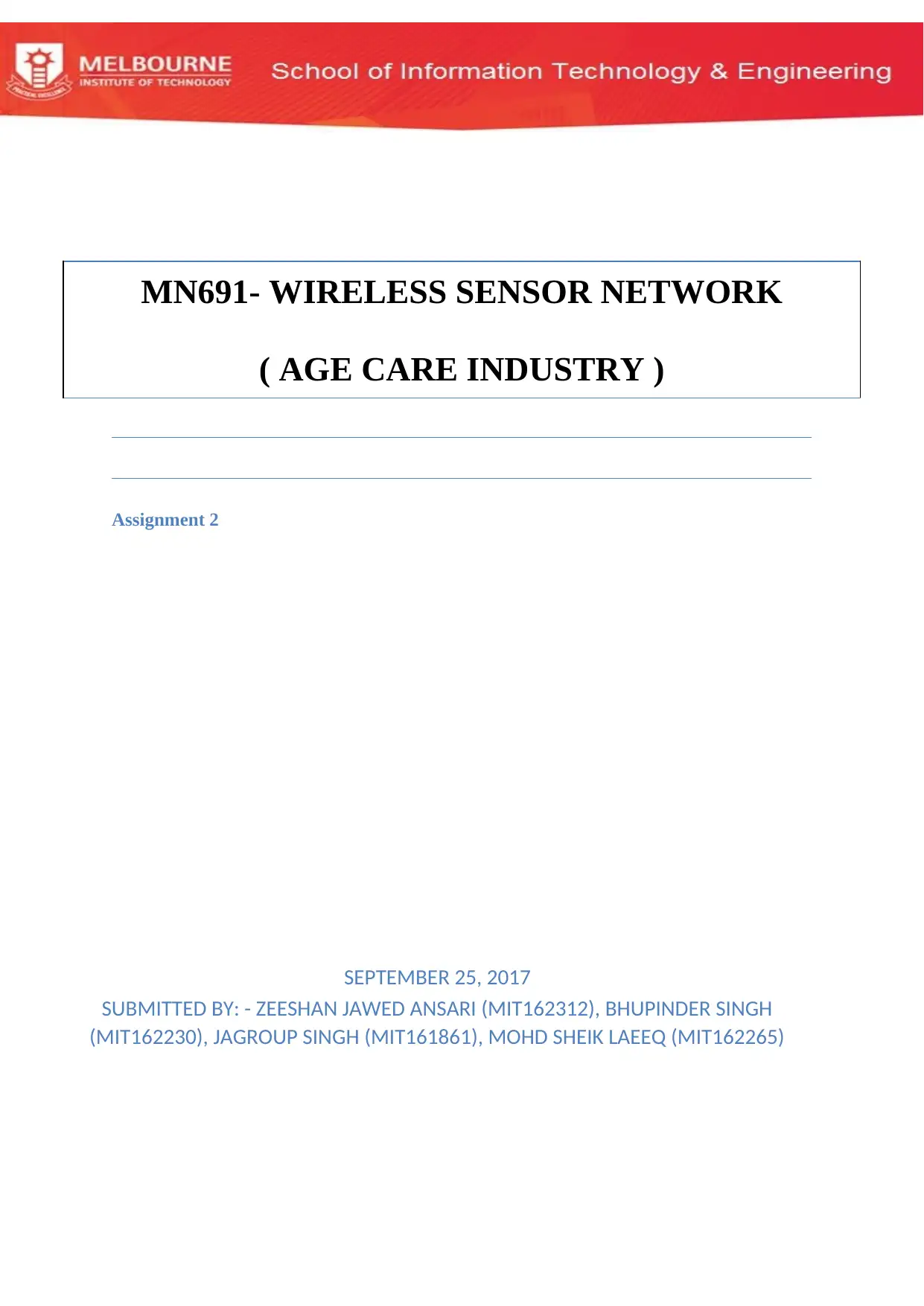
MN691- WIRELESS SENSOR NETWORK
( AGE CARE INDUSTRY )
Assignment 2
SEPTEMBER 25, 2017
SUBMITTED BY: - ZEESHAN JAWED ANSARI (MIT162312), BHUPINDER SINGH
(MIT162230), JAGROUP SINGH (MIT161861), MOHD SHEIK LAEEQ (MIT162265)
( AGE CARE INDUSTRY )
Assignment 2
SEPTEMBER 25, 2017
SUBMITTED BY: - ZEESHAN JAWED ANSARI (MIT162312), BHUPINDER SINGH
(MIT162230), JAGROUP SINGH (MIT161861), MOHD SHEIK LAEEQ (MIT162265)
Paraphrase This Document
Need a fresh take? Get an instant paraphrase of this document with our AI Paraphraser

MN691 Research Methods and Project Design Page 2 of 30
Acknowledgement
Signature of Students:
Sign your signature here
Date of Submission of Report: Put a date here clearly
2
Acknowledgement
Signature of Students:
Sign your signature here
Date of Submission of Report: Put a date here clearly
2
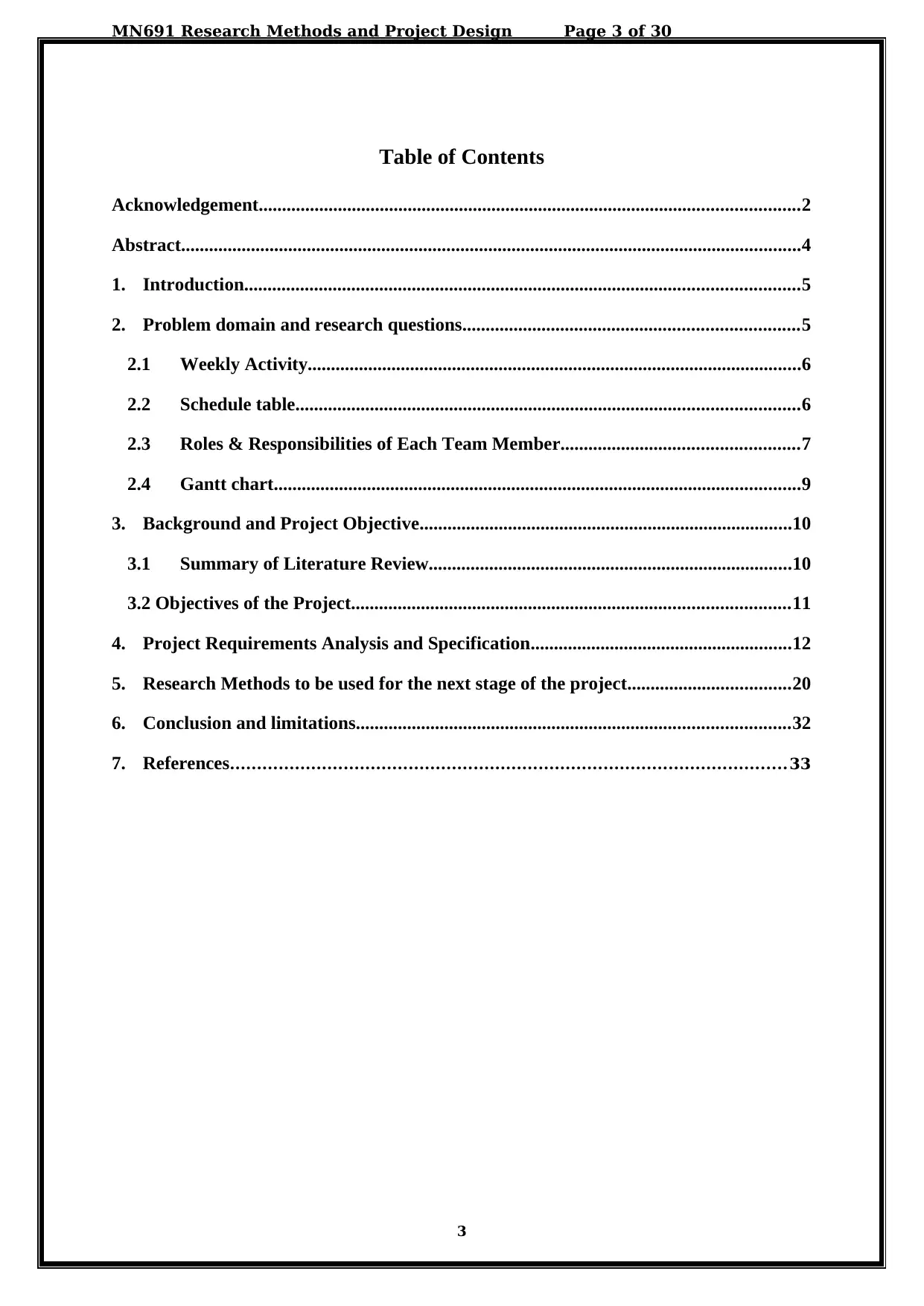
MN691 Research Methods and Project Design Page 3 of 30
Table of Contents
Acknowledgement....................................................................................................................2
Abstract.....................................................................................................................................4
1. Introduction.......................................................................................................................5
2. Problem domain and research questions........................................................................5
2.1 Weekly Activity..........................................................................................................6
2.2 Schedule table............................................................................................................6
2.3 Roles & Responsibilities of Each Team Member...................................................7
2.4 Gantt chart.................................................................................................................9
3. Background and Project Objective................................................................................10
3.1 Summary of Literature Review..............................................................................10
3.2 Objectives of the Project..............................................................................................11
4. Project Requirements Analysis and Specification........................................................12
5. Research Methods to be used for the next stage of the project...................................20
6. Conclusion and limitations.............................................................................................32
7. References....................................................................................................... 33
3
Table of Contents
Acknowledgement....................................................................................................................2
Abstract.....................................................................................................................................4
1. Introduction.......................................................................................................................5
2. Problem domain and research questions........................................................................5
2.1 Weekly Activity..........................................................................................................6
2.2 Schedule table............................................................................................................6
2.3 Roles & Responsibilities of Each Team Member...................................................7
2.4 Gantt chart.................................................................................................................9
3. Background and Project Objective................................................................................10
3.1 Summary of Literature Review..............................................................................10
3.2 Objectives of the Project..............................................................................................11
4. Project Requirements Analysis and Specification........................................................12
5. Research Methods to be used for the next stage of the project...................................20
6. Conclusion and limitations.............................................................................................32
7. References....................................................................................................... 33
3
⊘ This is a preview!⊘
Do you want full access?
Subscribe today to unlock all pages.

Trusted by 1+ million students worldwide
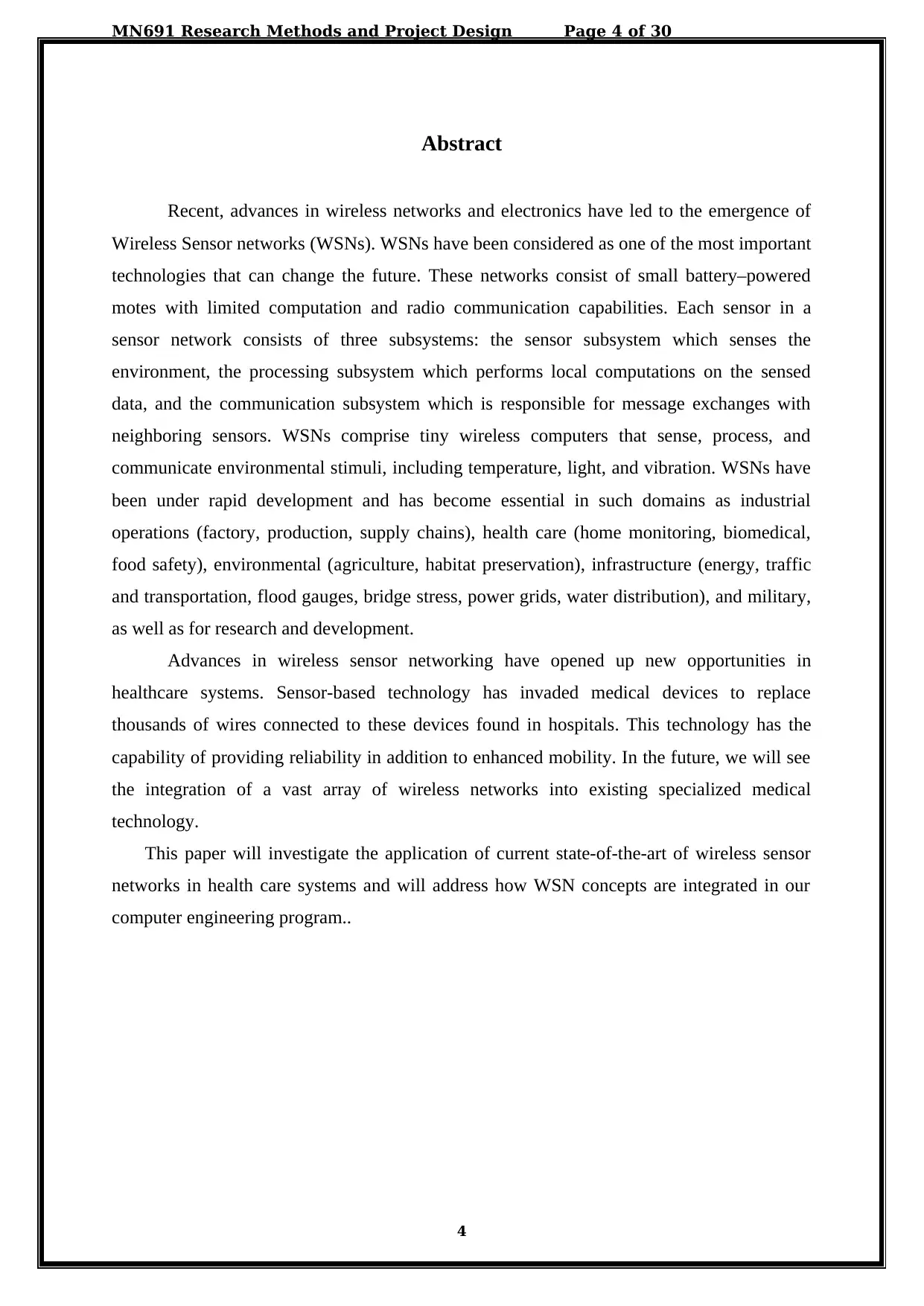
MN691 Research Methods and Project Design Page 4 of 30
Abstract
Recent, advances in wireless networks and electronics have led to the emergence of
Wireless Sensor networks (WSNs). WSNs have been considered as one of the most important
technologies that can change the future. These networks consist of small battery–powered
motes with limited computation and radio communication capabilities. Each sensor in a
sensor network consists of three subsystems: the sensor subsystem which senses the
environment, the processing subsystem which performs local computations on the sensed
data, and the communication subsystem which is responsible for message exchanges with
neighboring sensors. WSNs comprise tiny wireless computers that sense, process, and
communicate environmental stimuli, including temperature, light, and vibration. WSNs have
been under rapid development and has become essential in such domains as industrial
operations (factory, production, supply chains), health care (home monitoring, biomedical,
food safety), environmental (agriculture, habitat preservation), infrastructure (energy, traffic
and transportation, flood gauges, bridge stress, power grids, water distribution), and military,
as well as for research and development.
Advances in wireless sensor networking have opened up new opportunities in
healthcare systems. Sensor-based technology has invaded medical devices to replace
thousands of wires connected to these devices found in hospitals. This technology has the
capability of providing reliability in addition to enhanced mobility. In the future, we will see
the integration of a vast array of wireless networks into existing specialized medical
technology.
This paper will investigate the application of current state-of-the-art of wireless sensor
networks in health care systems and will address how WSN concepts are integrated in our
computer engineering program..
4
Abstract
Recent, advances in wireless networks and electronics have led to the emergence of
Wireless Sensor networks (WSNs). WSNs have been considered as one of the most important
technologies that can change the future. These networks consist of small battery–powered
motes with limited computation and radio communication capabilities. Each sensor in a
sensor network consists of three subsystems: the sensor subsystem which senses the
environment, the processing subsystem which performs local computations on the sensed
data, and the communication subsystem which is responsible for message exchanges with
neighboring sensors. WSNs comprise tiny wireless computers that sense, process, and
communicate environmental stimuli, including temperature, light, and vibration. WSNs have
been under rapid development and has become essential in such domains as industrial
operations (factory, production, supply chains), health care (home monitoring, biomedical,
food safety), environmental (agriculture, habitat preservation), infrastructure (energy, traffic
and transportation, flood gauges, bridge stress, power grids, water distribution), and military,
as well as for research and development.
Advances in wireless sensor networking have opened up new opportunities in
healthcare systems. Sensor-based technology has invaded medical devices to replace
thousands of wires connected to these devices found in hospitals. This technology has the
capability of providing reliability in addition to enhanced mobility. In the future, we will see
the integration of a vast array of wireless networks into existing specialized medical
technology.
This paper will investigate the application of current state-of-the-art of wireless sensor
networks in health care systems and will address how WSN concepts are integrated in our
computer engineering program..
4
Paraphrase This Document
Need a fresh take? Get an instant paraphrase of this document with our AI Paraphraser
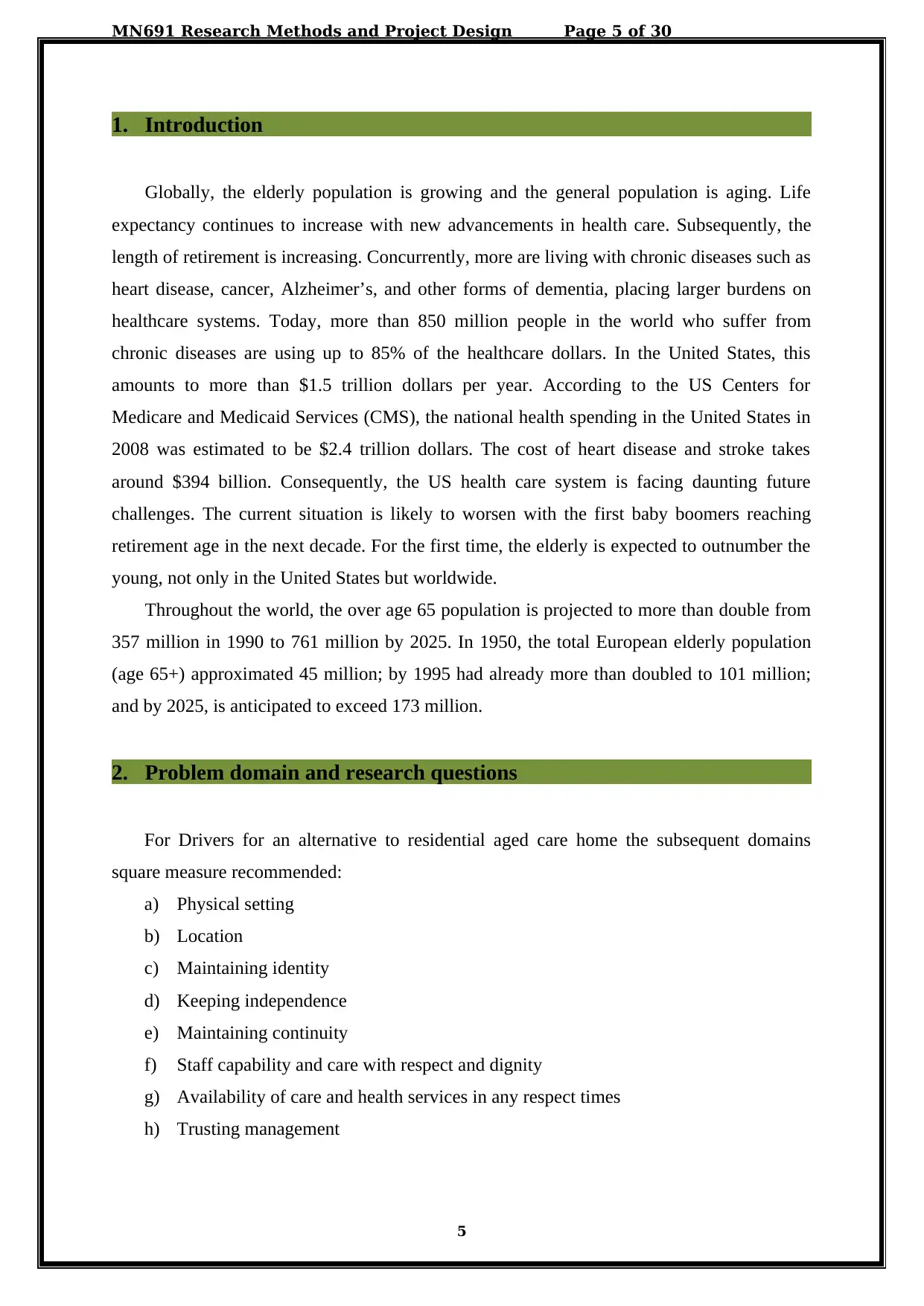
MN691 Research Methods and Project Design Page 5 of 30
1. Introduction
Globally, the elderly population is growing and the general population is aging. Life
expectancy continues to increase with new advancements in health care. Subsequently, the
length of retirement is increasing. Concurrently, more are living with chronic diseases such as
heart disease, cancer, Alzheimer’s, and other forms of dementia, placing larger burdens on
healthcare systems. Today, more than 850 million people in the world who suffer from
chronic diseases are using up to 85% of the healthcare dollars. In the United States, this
amounts to more than $1.5 trillion dollars per year. According to the US Centers for
Medicare and Medicaid Services (CMS), the national health spending in the United States in
2008 was estimated to be $2.4 trillion dollars. The cost of heart disease and stroke takes
around $394 billion. Consequently, the US health care system is facing daunting future
challenges. The current situation is likely to worsen with the first baby boomers reaching
retirement age in the next decade. For the first time, the elderly is expected to outnumber the
young, not only in the United States but worldwide.
Throughout the world, the over age 65 population is projected to more than double from
357 million in 1990 to 761 million by 2025. In 1950, the total European elderly population
(age 65+) approximated 45 million; by 1995 had already more than doubled to 101 million;
and by 2025, is anticipated to exceed 173 million.
2. Problem domain and research questions
For Drivers for an alternative to residential aged care home the subsequent domains
square measure recommended:
a) Physical setting
b) Location
c) Maintaining identity
d) Keeping independence
e) Maintaining continuity
f) Staff capability and care with respect and dignity
g) Availability of care and health services in any respect times
h) Trusting management
5
1. Introduction
Globally, the elderly population is growing and the general population is aging. Life
expectancy continues to increase with new advancements in health care. Subsequently, the
length of retirement is increasing. Concurrently, more are living with chronic diseases such as
heart disease, cancer, Alzheimer’s, and other forms of dementia, placing larger burdens on
healthcare systems. Today, more than 850 million people in the world who suffer from
chronic diseases are using up to 85% of the healthcare dollars. In the United States, this
amounts to more than $1.5 trillion dollars per year. According to the US Centers for
Medicare and Medicaid Services (CMS), the national health spending in the United States in
2008 was estimated to be $2.4 trillion dollars. The cost of heart disease and stroke takes
around $394 billion. Consequently, the US health care system is facing daunting future
challenges. The current situation is likely to worsen with the first baby boomers reaching
retirement age in the next decade. For the first time, the elderly is expected to outnumber the
young, not only in the United States but worldwide.
Throughout the world, the over age 65 population is projected to more than double from
357 million in 1990 to 761 million by 2025. In 1950, the total European elderly population
(age 65+) approximated 45 million; by 1995 had already more than doubled to 101 million;
and by 2025, is anticipated to exceed 173 million.
2. Problem domain and research questions
For Drivers for an alternative to residential aged care home the subsequent domains
square measure recommended:
a) Physical setting
b) Location
c) Maintaining identity
d) Keeping independence
e) Maintaining continuity
f) Staff capability and care with respect and dignity
g) Availability of care and health services in any respect times
h) Trusting management
5
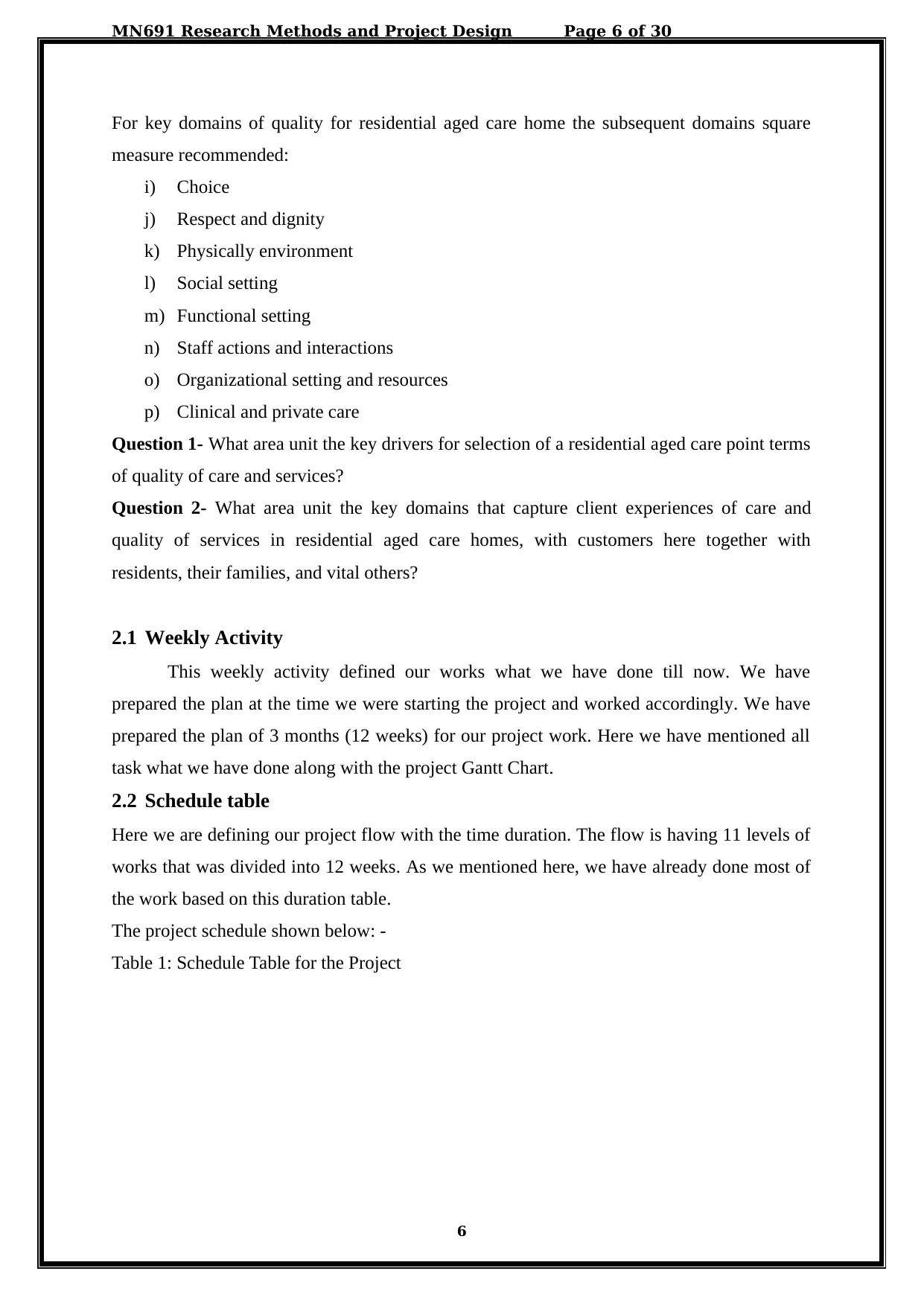
MN691 Research Methods and Project Design Page 6 of 30
For key domains of quality for residential aged care home the subsequent domains square
measure recommended:
i) Choice
j) Respect and dignity
k) Physically environment
l) Social setting
m) Functional setting
n) Staff actions and interactions
o) Organizational setting and resources
p) Clinical and private care
Question 1- What area unit the key drivers for selection of a residential aged care point terms
of quality of care and services?
Question 2- What area unit the key domains that capture client experiences of care and
quality of services in residential aged care homes, with customers here together with
residents, their families, and vital others?
2.1 Weekly Activity
This weekly activity defined our works what we have done till now. We have
prepared the plan at the time we were starting the project and worked accordingly. We have
prepared the plan of 3 months (12 weeks) for our project work. Here we have mentioned all
task what we have done along with the project Gantt Chart.
2.2 Schedule table
Here we are defining our project flow with the time duration. The flow is having 11 levels of
works that was divided into 12 weeks. As we mentioned here, we have already done most of
the work based on this duration table.
The project schedule shown below: -
Table 1: Schedule Table for the Project
6
For key domains of quality for residential aged care home the subsequent domains square
measure recommended:
i) Choice
j) Respect and dignity
k) Physically environment
l) Social setting
m) Functional setting
n) Staff actions and interactions
o) Organizational setting and resources
p) Clinical and private care
Question 1- What area unit the key drivers for selection of a residential aged care point terms
of quality of care and services?
Question 2- What area unit the key domains that capture client experiences of care and
quality of services in residential aged care homes, with customers here together with
residents, their families, and vital others?
2.1 Weekly Activity
This weekly activity defined our works what we have done till now. We have
prepared the plan at the time we were starting the project and worked accordingly. We have
prepared the plan of 3 months (12 weeks) for our project work. Here we have mentioned all
task what we have done along with the project Gantt Chart.
2.2 Schedule table
Here we are defining our project flow with the time duration. The flow is having 11 levels of
works that was divided into 12 weeks. As we mentioned here, we have already done most of
the work based on this duration table.
The project schedule shown below: -
Table 1: Schedule Table for the Project
6
⊘ This is a preview!⊘
Do you want full access?
Subscribe today to unlock all pages.

Trusted by 1+ million students worldwide
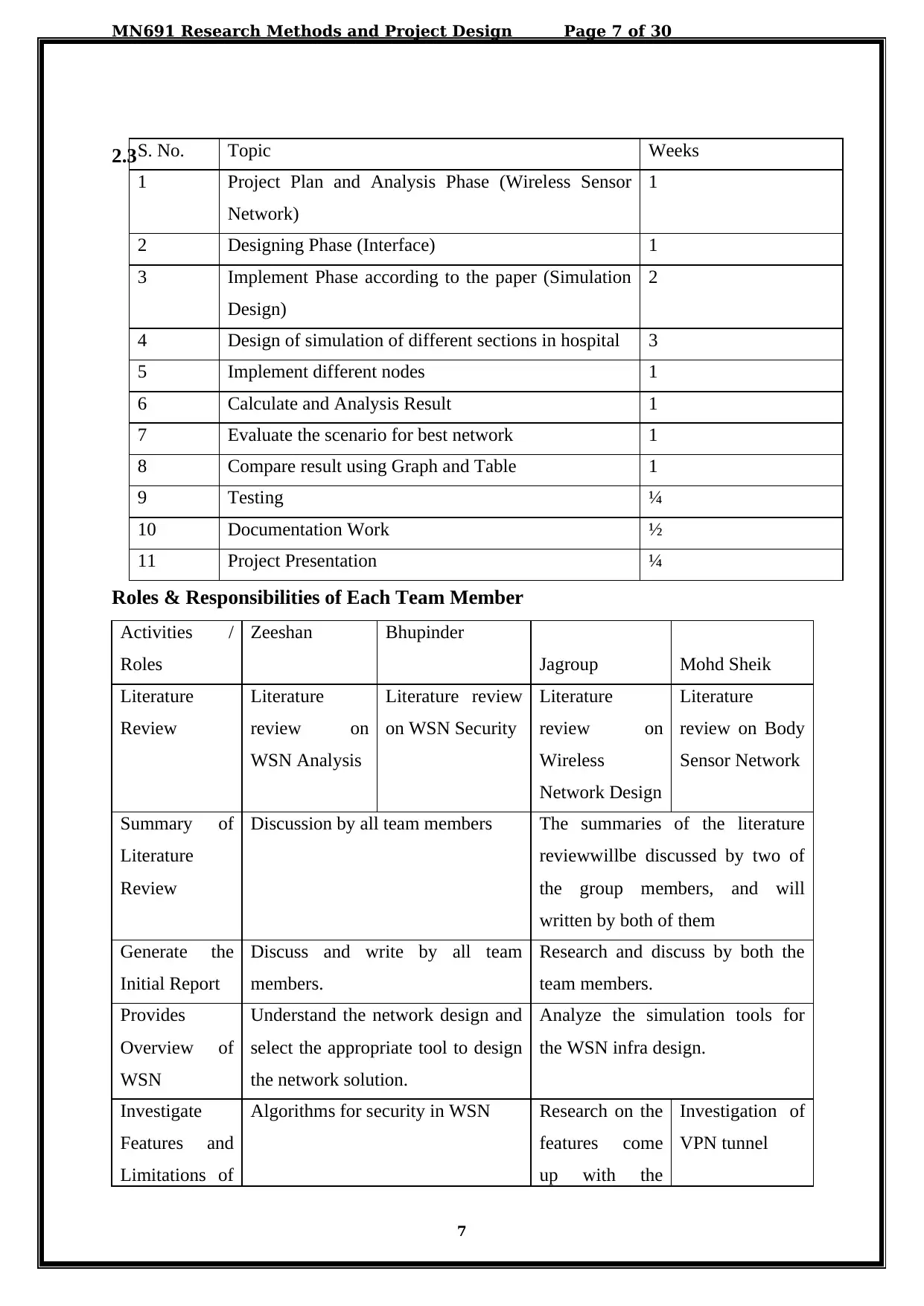
MN691 Research Methods and Project Design Page 7 of 30
2.3
Roles & Responsibilities of Each Team Member
Activities /
Roles
Zeeshan Bhupinder
Jagroup Mohd Sheik
Literature
Review
Literature
review on
WSN Analysis
Literature review
on WSN Security
Literature
review on
Wireless
Network Design
Literature
review on Body
Sensor Network
Summary of
Literature
Review
Discussion by all team members The summaries of the literature
reviewwillbe discussed by two of
the group members, and will
written by both of them
Generate the
Initial Report
Discuss and write by all team
members.
Research and discuss by both the
team members.
Provides
Overview of
WSN
Understand the network design and
select the appropriate tool to design
the network solution.
Analyze the simulation tools for
the WSN infra design.
Investigate
Features and
Limitations of
Algorithms for security in WSN Research on the
features come
up with the
Investigation of
VPN tunnel
7
S. No. Topic Weeks
1 Project Plan and Analysis Phase (Wireless Sensor
Network)
1
2 Designing Phase (Interface) 1
3 Implement Phase according to the paper (Simulation
Design)
2
4 Design of simulation of different sections in hospital 3
5 Implement different nodes 1
6 Calculate and Analysis Result 1
7 Evaluate the scenario for best network 1
8 Compare result using Graph and Table 1
9 Testing ¼
10 Documentation Work ½
11 Project Presentation ¼
2.3
Roles & Responsibilities of Each Team Member
Activities /
Roles
Zeeshan Bhupinder
Jagroup Mohd Sheik
Literature
Review
Literature
review on
WSN Analysis
Literature review
on WSN Security
Literature
review on
Wireless
Network Design
Literature
review on Body
Sensor Network
Summary of
Literature
Review
Discussion by all team members The summaries of the literature
reviewwillbe discussed by two of
the group members, and will
written by both of them
Generate the
Initial Report
Discuss and write by all team
members.
Research and discuss by both the
team members.
Provides
Overview of
WSN
Understand the network design and
select the appropriate tool to design
the network solution.
Analyze the simulation tools for
the WSN infra design.
Investigate
Features and
Limitations of
Algorithms for security in WSN Research on the
features come
up with the
Investigation of
VPN tunnel
7
S. No. Topic Weeks
1 Project Plan and Analysis Phase (Wireless Sensor
Network)
1
2 Designing Phase (Interface) 1
3 Implement Phase according to the paper (Simulation
Design)
2
4 Design of simulation of different sections in hospital 3
5 Implement different nodes 1
6 Calculate and Analysis Result 1
7 Evaluate the scenario for best network 1
8 Compare result using Graph and Table 1
9 Testing ¼
10 Documentation Work ½
11 Project Presentation ¼
Paraphrase This Document
Need a fresh take? Get an instant paraphrase of this document with our AI Paraphraser
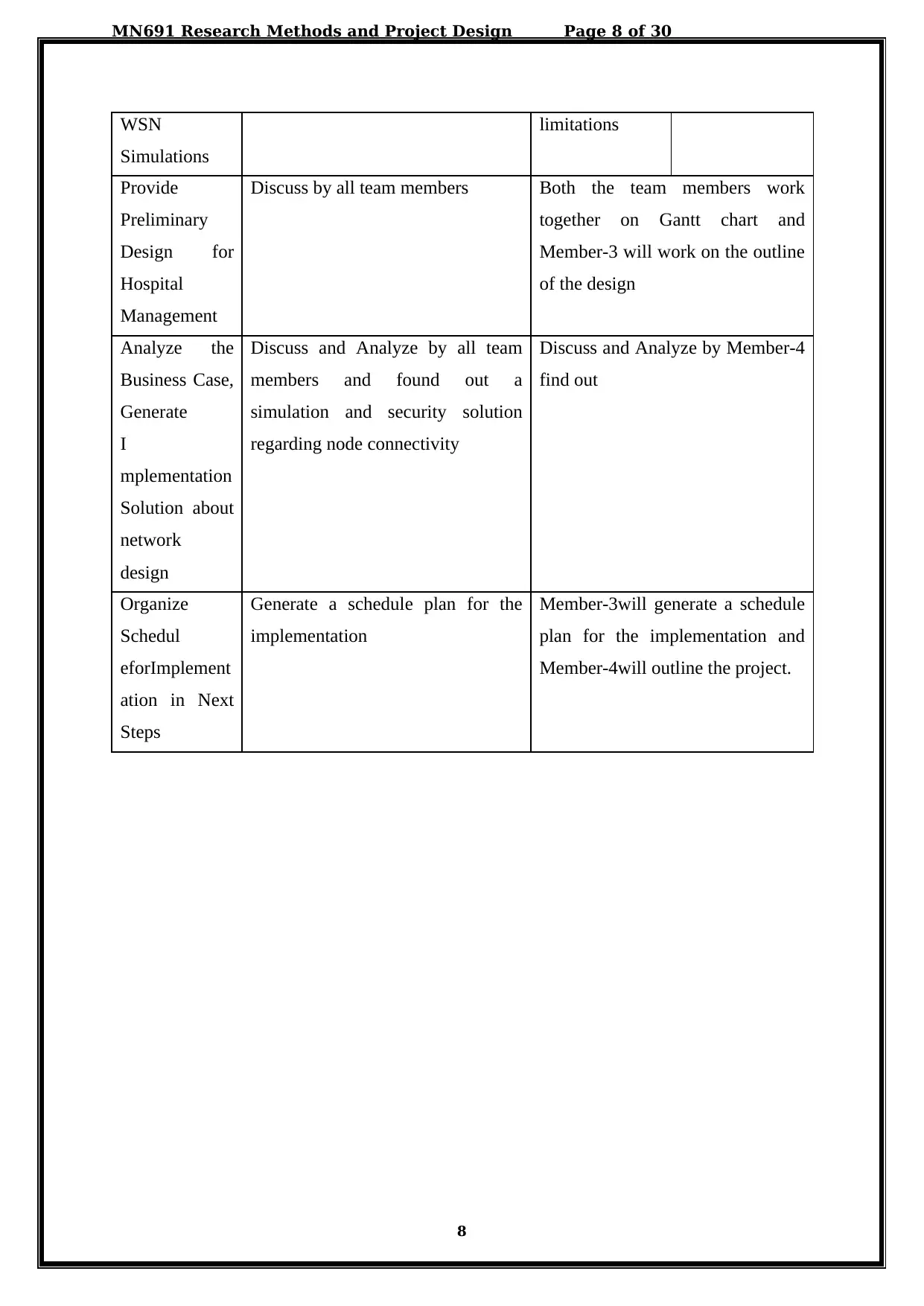
MN691 Research Methods and Project Design Page 8 of 30
WSN
Simulations
limitations
Provide
Preliminary
Design for
Hospital
Management
Discuss by all team members Both the team members work
together on Gantt chart and
Member-3 will work on the outline
of the design
Analyze the
Business Case,
Generate
I
mplementation
Solution about
network
design
Discuss and Analyze by all team
members and found out a
simulation and security solution
regarding node connectivity
Discuss and Analyze by Member-4
find out
Organize
Schedul
eforImplement
ation in Next
Steps
Generate a schedule plan for the
implementation
Member-3will generate a schedule
plan for the implementation and
Member-4will outline the project.
8
WSN
Simulations
limitations
Provide
Preliminary
Design for
Hospital
Management
Discuss by all team members Both the team members work
together on Gantt chart and
Member-3 will work on the outline
of the design
Analyze the
Business Case,
Generate
I
mplementation
Solution about
network
design
Discuss and Analyze by all team
members and found out a
simulation and security solution
regarding node connectivity
Discuss and Analyze by Member-4
find out
Organize
Schedul
eforImplement
ation in Next
Steps
Generate a schedule plan for the
implementation
Member-3will generate a schedule
plan for the implementation and
Member-4will outline the project.
8
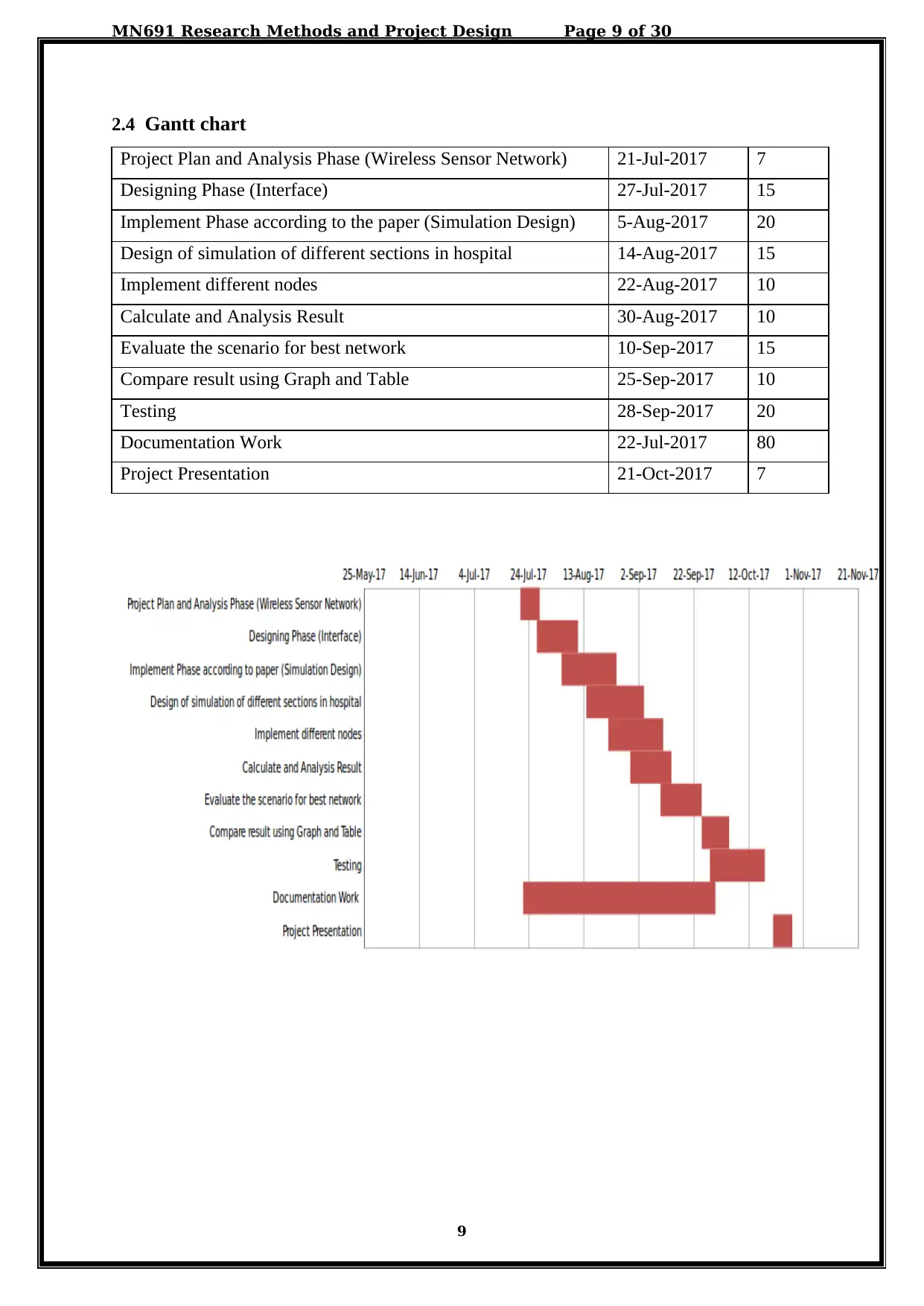
MN691 Research Methods and Project Design Page 9 of 30
2.4 Gantt chart
Project Plan and Analysis Phase (Wireless Sensor Network) 21-Jul-2017 7
Designing Phase (Interface) 27-Jul-2017 15
Implement Phase according to the paper (Simulation Design) 5-Aug-2017 20
Design of simulation of different sections in hospital 14-Aug-2017 15
Implement different nodes 22-Aug-2017 10
Calculate and Analysis Result 30-Aug-2017 10
Evaluate the scenario for best network 10-Sep-2017 15
Compare result using Graph and Table 25-Sep-2017 10
Testing 28-Sep-2017 20
Documentation Work 22-Jul-2017 80
Project Presentation 21-Oct-2017 7
9
2.4 Gantt chart
Project Plan and Analysis Phase (Wireless Sensor Network) 21-Jul-2017 7
Designing Phase (Interface) 27-Jul-2017 15
Implement Phase according to the paper (Simulation Design) 5-Aug-2017 20
Design of simulation of different sections in hospital 14-Aug-2017 15
Implement different nodes 22-Aug-2017 10
Calculate and Analysis Result 30-Aug-2017 10
Evaluate the scenario for best network 10-Sep-2017 15
Compare result using Graph and Table 25-Sep-2017 10
Testing 28-Sep-2017 20
Documentation Work 22-Jul-2017 80
Project Presentation 21-Oct-2017 7
9
⊘ This is a preview!⊘
Do you want full access?
Subscribe today to unlock all pages.

Trusted by 1+ million students worldwide
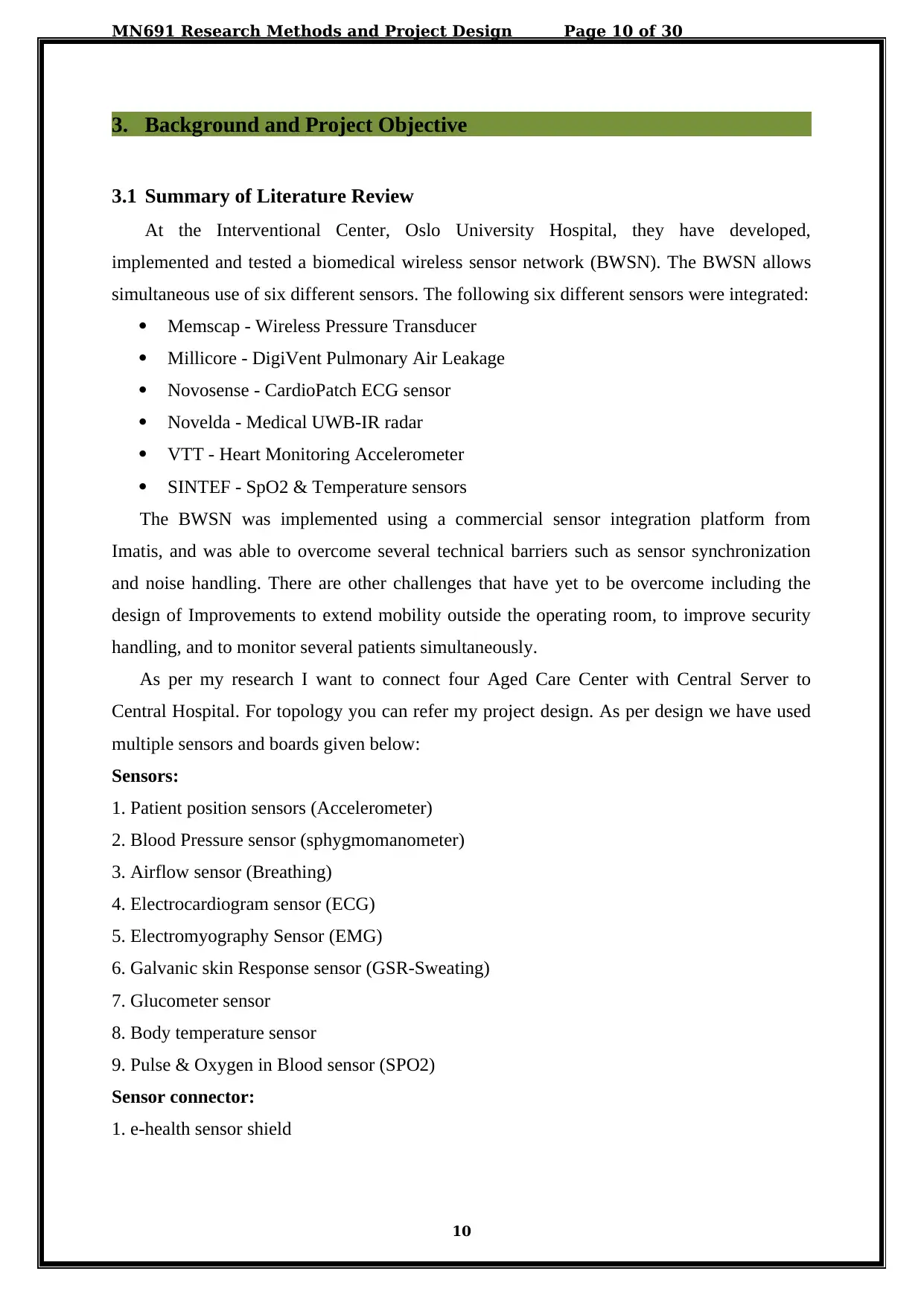
MN691 Research Methods and Project Design Page 10 of 30
3. Background and Project Objective
3.1 Summary of Literature Review
At the Interventional Center, Oslo University Hospital, they have developed,
implemented and tested a biomedical wireless sensor network (BWSN). The BWSN allows
simultaneous use of six different sensors. The following six different sensors were integrated:
Memscap - Wireless Pressure Transducer
Millicore - DigiVent Pulmonary Air Leakage
Novosense - CardioPatch ECG sensor
Novelda - Medical UWB-IR radar
VTT - Heart Monitoring Accelerometer
SINTEF - SpO2 & Temperature sensors
The BWSN was implemented using a commercial sensor integration platform from
Imatis, and was able to overcome several technical barriers such as sensor synchronization
and noise handling. There are other challenges that have yet to be overcome including the
design of Improvements to extend mobility outside the operating room, to improve security
handling, and to monitor several patients simultaneously.
As per my research I want to connect four Aged Care Center with Central Server to
Central Hospital. For topology you can refer my project design. As per design we have used
multiple sensors and boards given below:
Sensors:
1. Patient position sensors (Accelerometer)
2. Blood Pressure sensor (sphygmomanometer)
3. Airflow sensor (Breathing)
4. Electrocardiogram sensor (ECG)
5. Electromyography Sensor (EMG)
6. Galvanic skin Response sensor (GSR-Sweating)
7. Glucometer sensor
8. Body temperature sensor
9. Pulse & Oxygen in Blood sensor (SPO2)
Sensor connector:
1. e-health sensor shield
10
3. Background and Project Objective
3.1 Summary of Literature Review
At the Interventional Center, Oslo University Hospital, they have developed,
implemented and tested a biomedical wireless sensor network (BWSN). The BWSN allows
simultaneous use of six different sensors. The following six different sensors were integrated:
Memscap - Wireless Pressure Transducer
Millicore - DigiVent Pulmonary Air Leakage
Novosense - CardioPatch ECG sensor
Novelda - Medical UWB-IR radar
VTT - Heart Monitoring Accelerometer
SINTEF - SpO2 & Temperature sensors
The BWSN was implemented using a commercial sensor integration platform from
Imatis, and was able to overcome several technical barriers such as sensor synchronization
and noise handling. There are other challenges that have yet to be overcome including the
design of Improvements to extend mobility outside the operating room, to improve security
handling, and to monitor several patients simultaneously.
As per my research I want to connect four Aged Care Center with Central Server to
Central Hospital. For topology you can refer my project design. As per design we have used
multiple sensors and boards given below:
Sensors:
1. Patient position sensors (Accelerometer)
2. Blood Pressure sensor (sphygmomanometer)
3. Airflow sensor (Breathing)
4. Electrocardiogram sensor (ECG)
5. Electromyography Sensor (EMG)
6. Galvanic skin Response sensor (GSR-Sweating)
7. Glucometer sensor
8. Body temperature sensor
9. Pulse & Oxygen in Blood sensor (SPO2)
Sensor connector:
1. e-health sensor shield
10
Paraphrase This Document
Need a fresh take? Get an instant paraphrase of this document with our AI Paraphraser
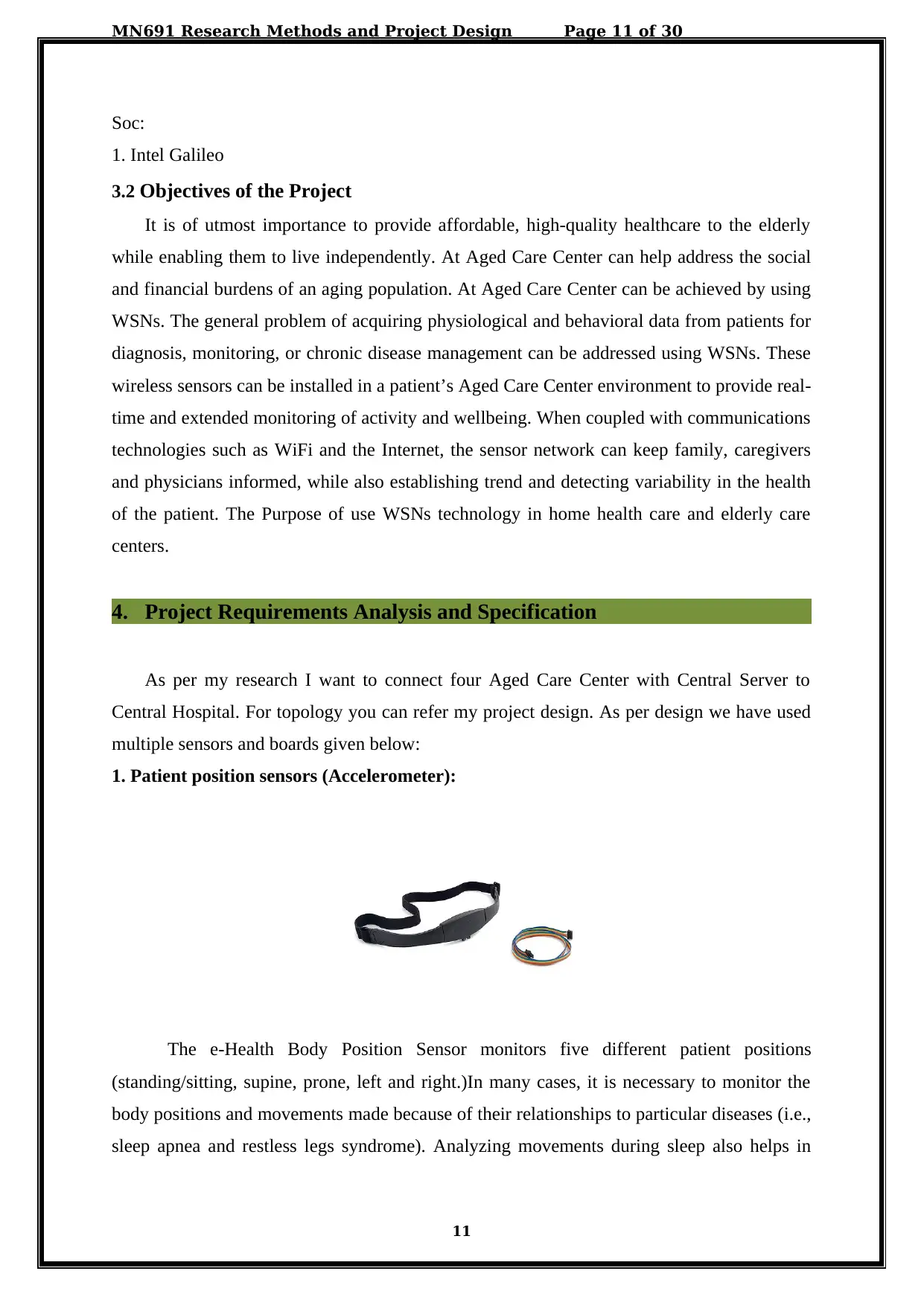
MN691 Research Methods and Project Design Page 11 of 30
Soc:
1. Intel Galileo
3.2 Objectives of the Project
It is of utmost importance to provide affordable, high-quality healthcare to the elderly
while enabling them to live independently. At Aged Care Center can help address the social
and financial burdens of an aging population. At Aged Care Center can be achieved by using
WSNs. The general problem of acquiring physiological and behavioral data from patients for
diagnosis, monitoring, or chronic disease management can be addressed using WSNs. These
wireless sensors can be installed in a patient’s Aged Care Center environment to provide real-
time and extended monitoring of activity and wellbeing. When coupled with communications
technologies such as WiFi and the Internet, the sensor network can keep family, caregivers
and physicians informed, while also establishing trend and detecting variability in the health
of the patient. The Purpose of use WSNs technology in home health care and elderly care
centers.
4. Project Requirements Analysis and Specification
As per my research I want to connect four Aged Care Center with Central Server to
Central Hospital. For topology you can refer my project design. As per design we have used
multiple sensors and boards given below:
1. Patient position sensors (Accelerometer):
The e-Health Body Position Sensor monitors five different patient positions
(standing/sitting, supine, prone, left and right.)In many cases, it is necessary to monitor the
body positions and movements made because of their relationships to particular diseases (i.e.,
sleep apnea and restless legs syndrome). Analyzing movements during sleep also helps in
11
Soc:
1. Intel Galileo
3.2 Objectives of the Project
It is of utmost importance to provide affordable, high-quality healthcare to the elderly
while enabling them to live independently. At Aged Care Center can help address the social
and financial burdens of an aging population. At Aged Care Center can be achieved by using
WSNs. The general problem of acquiring physiological and behavioral data from patients for
diagnosis, monitoring, or chronic disease management can be addressed using WSNs. These
wireless sensors can be installed in a patient’s Aged Care Center environment to provide real-
time and extended monitoring of activity and wellbeing. When coupled with communications
technologies such as WiFi and the Internet, the sensor network can keep family, caregivers
and physicians informed, while also establishing trend and detecting variability in the health
of the patient. The Purpose of use WSNs technology in home health care and elderly care
centers.
4. Project Requirements Analysis and Specification
As per my research I want to connect four Aged Care Center with Central Server to
Central Hospital. For topology you can refer my project design. As per design we have used
multiple sensors and boards given below:
1. Patient position sensors (Accelerometer):
The e-Health Body Position Sensor monitors five different patient positions
(standing/sitting, supine, prone, left and right.)In many cases, it is necessary to monitor the
body positions and movements made because of their relationships to particular diseases (i.e.,
sleep apnea and restless legs syndrome). Analyzing movements during sleep also helps in
11
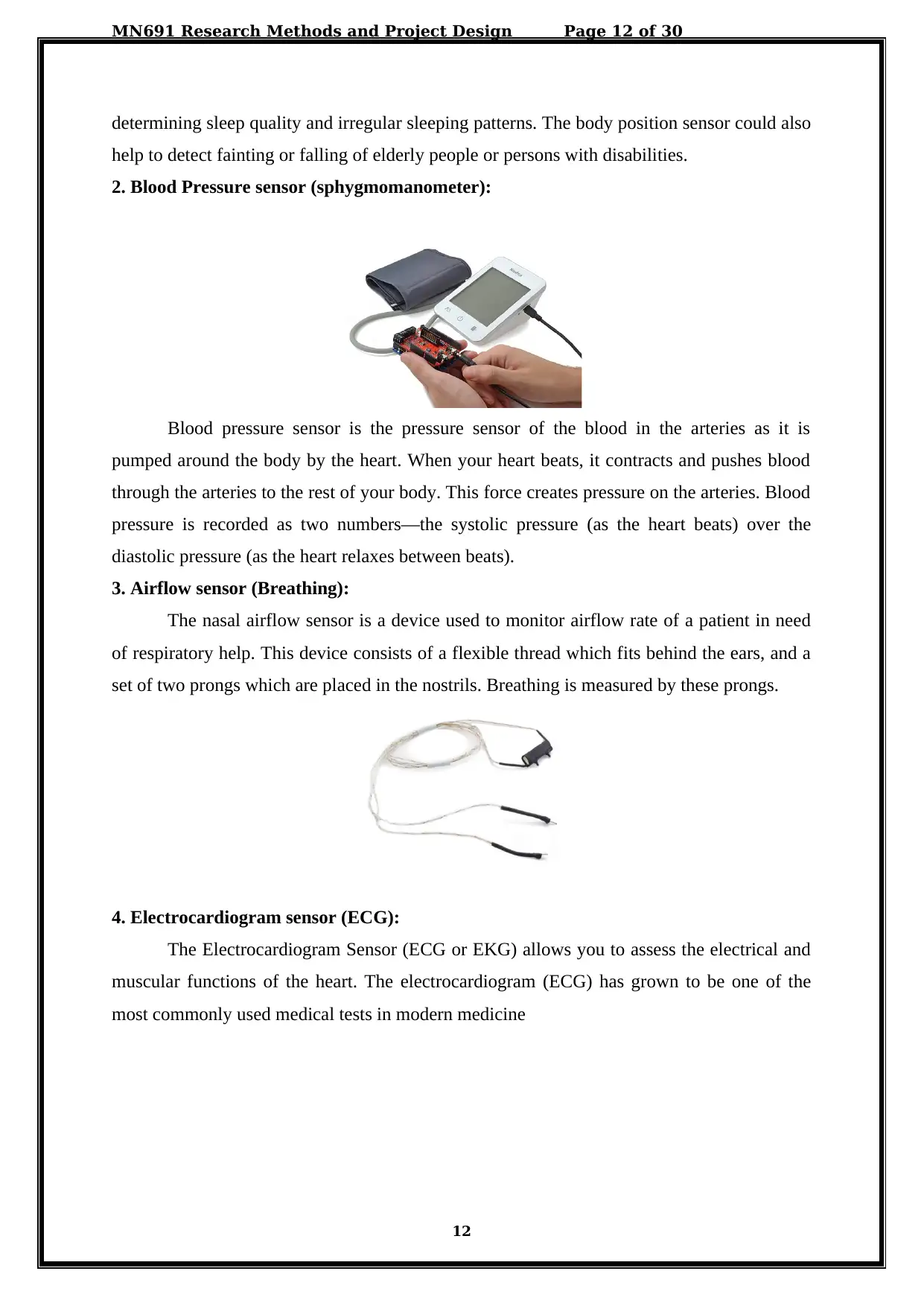
MN691 Research Methods and Project Design Page 12 of 30
determining sleep quality and irregular sleeping patterns. The body position sensor could also
help to detect fainting or falling of elderly people or persons with disabilities.
2. Blood Pressure sensor (sphygmomanometer):
Blood pressure sensor is the pressure sensor of the blood in the arteries as it is
pumped around the body by the heart. When your heart beats, it contracts and pushes blood
through the arteries to the rest of your body. This force creates pressure on the arteries. Blood
pressure is recorded as two numbers—the systolic pressure (as the heart beats) over the
diastolic pressure (as the heart relaxes between beats).
3. Airflow sensor (Breathing):
The nasal airflow sensor is a device used to monitor airflow rate of a patient in need
of respiratory help. This device consists of a flexible thread which fits behind the ears, and a
set of two prongs which are placed in the nostrils. Breathing is measured by these prongs.
4. Electrocardiogram sensor (ECG):
The Electrocardiogram Sensor (ECG or EKG) allows you to assess the electrical and
muscular functions of the heart. The electrocardiogram (ECG) has grown to be one of the
most commonly used medical tests in modern medicine
12
determining sleep quality and irregular sleeping patterns. The body position sensor could also
help to detect fainting or falling of elderly people or persons with disabilities.
2. Blood Pressure sensor (sphygmomanometer):
Blood pressure sensor is the pressure sensor of the blood in the arteries as it is
pumped around the body by the heart. When your heart beats, it contracts and pushes blood
through the arteries to the rest of your body. This force creates pressure on the arteries. Blood
pressure is recorded as two numbers—the systolic pressure (as the heart beats) over the
diastolic pressure (as the heart relaxes between beats).
3. Airflow sensor (Breathing):
The nasal airflow sensor is a device used to monitor airflow rate of a patient in need
of respiratory help. This device consists of a flexible thread which fits behind the ears, and a
set of two prongs which are placed in the nostrils. Breathing is measured by these prongs.
4. Electrocardiogram sensor (ECG):
The Electrocardiogram Sensor (ECG or EKG) allows you to assess the electrical and
muscular functions of the heart. The electrocardiogram (ECG) has grown to be one of the
most commonly used medical tests in modern medicine
12
⊘ This is a preview!⊘
Do you want full access?
Subscribe today to unlock all pages.

Trusted by 1+ million students worldwide
1 out of 30
Related Documents
Your All-in-One AI-Powered Toolkit for Academic Success.
+13062052269
info@desklib.com
Available 24*7 on WhatsApp / Email
![[object Object]](/_next/static/media/star-bottom.7253800d.svg)
Unlock your academic potential
Copyright © 2020–2025 A2Z Services. All Rights Reserved. Developed and managed by ZUCOL.




